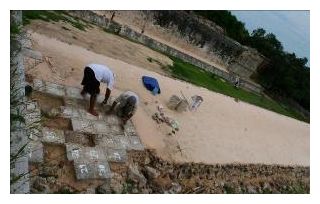
© Latin American Herald Tribune
Mexico City - Restoration works at Chichen Itza have confirmed the hypothesis that the ballgame played in that ancient Mayan city in southeastern Mexico had an astronomical function, the National Anthropology and History Institute, or INAH, said.
After almost two years of restoration and preservation work, the Great Ballcourt at Chichen Itza, at 120 meters (130 yards) long the largest in Mesoamerica, is gradually recovering its original appearance with the reincorporation of different elements, including the five "passages" that the ancient Mayas built on the site.
The passages are structures that, according to recent studies, were used to observe the path of the sun during the equinoxes and solstices, INAH said in a communique.
Archaeologist Jose Huchim, coordinator of the Chichen Itza comprehensive conservation project, said that observers were possibly stationed in those structures to follow the game and see if the ball went through the vertical stone ring and make sure players hit the ball according to the rules of the ritual.
Huchim said that 25 years ago, when he was studying archaeology, he observed the site with his then-professor Victor Segovia, a pioneer in the study of pre-Colombian astronomy, because both were convinced that the passages were oriented to the equinoxes and solstices.
"We found that the central passage did have an orientation that permitted a view of the equinoxes - that's why we thought it important to restore all five to determine whether all of them were built in line with the extreme (nearest and farthest) distances of the sun from the equator," he said.
Last year, as part of the comprehensive restoration project of the ballcourt, which dates back to 864 A.D., "we returned the five passages to 90 percent of their original form," the INAH researcher said.
"I began making astronomical observations and could prove that one of them marks the winter solstice, while the central passages marked the equinoxes, and those toward the north, the summer solstice," he said.
He recalled that for pre-Colombian Mayas, the sun was a vital element in their rituals for marking the change of seasons and to begin preparing the land for growing maize - the ball is an analogy of the sun and the movements of the game are an analogy of the sun's trajectory.
"The arc of the sun, which rises in the east, reaches its zenith and disappears in the west, at a certain moment was reproduced with the movement of the ball during the ritual," Huchim said.

Reader Comments
to our Newsletter